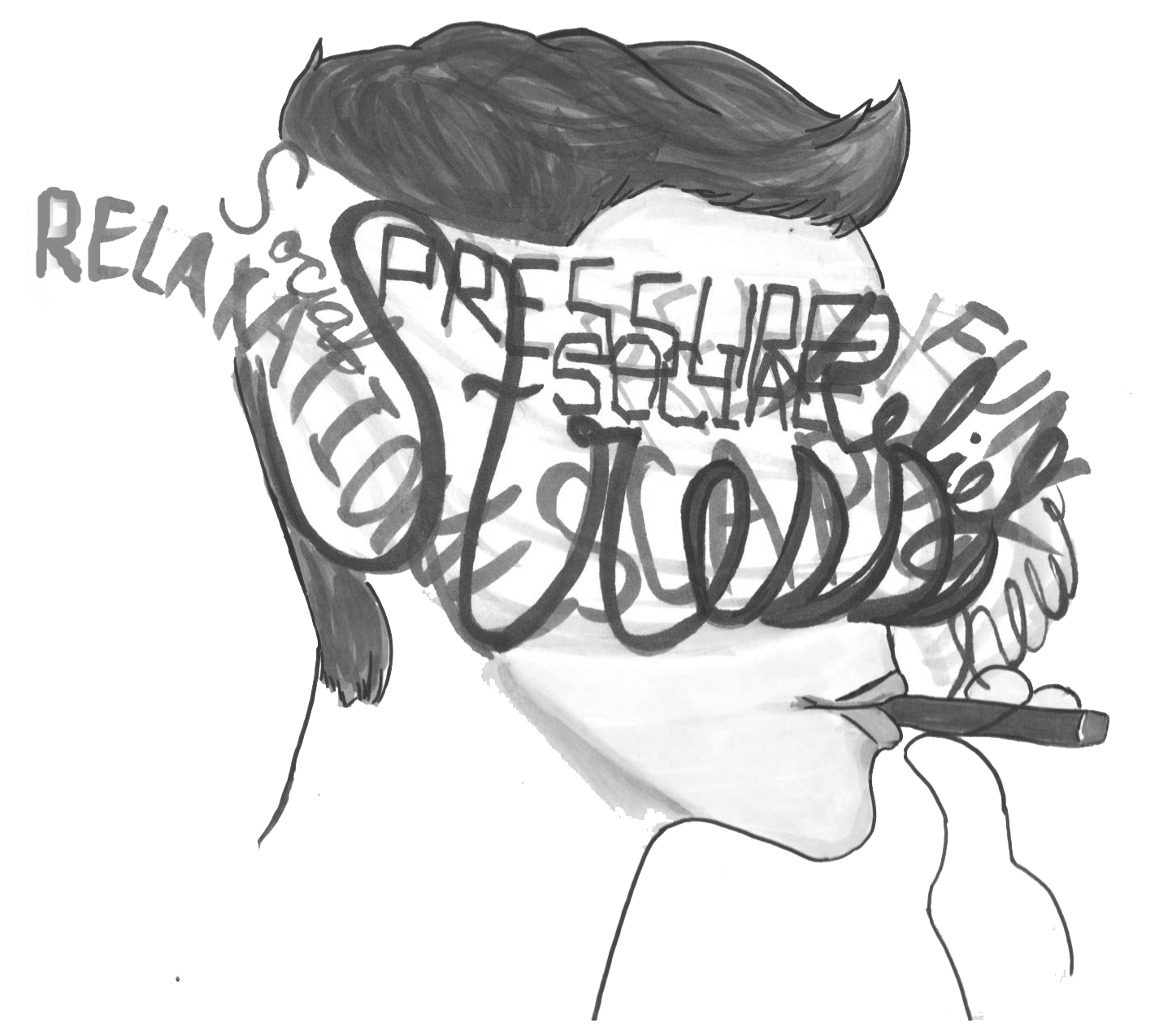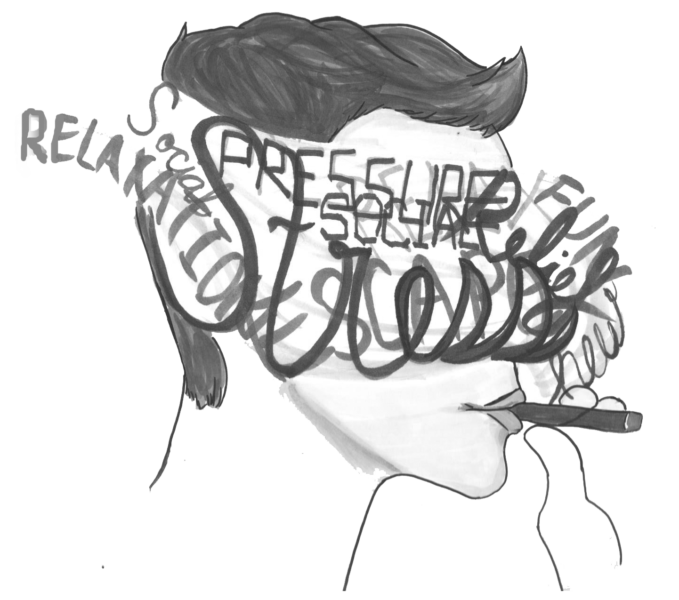
By Gabriel Lukaszewicz and Katie Savage
High School, High Students
Aragon junior Sam* smoked weed for the first time behind an apartment building. “Me and an old friend of mine just went back there and we got lit. It was pretty fun. Then we went swimming high.” Despite being an illegal activity, marijuana usage has a place among Aragon students. Similar to Sam, some use it casually with friends, yet must take caution to avoid being caught.
Cannabis, a type of hemp plant, is one of the oldest psychoactive substances in human history. It can be consumed in a variety of ways, such as smoking, vaporizing or eating. Marijuana’s primary active ingredient, THC, is responsible for pleasure, time perception, and pain. Although marijuana is illegal for recreational use, California has legalized its use in medicine, with its primary use being to relieve pain. Biology teacher Katherine Ward discusses the medicinal benefits of marijuana, saying, “The cannabinoids, which are some of the molecules the plants produces…have positive effects for individuals who have diseases or disorders, for example in cancer or AIDS patients … [they] help to mitigate wasting.”
Considering its status as an illegal drug, marijuana is fairly easy to attain. Junior Jason* explains, “We have friends that can get it for us, or we can go and get it ourselves from a dealer.” For a substance whose possession can result in an infraction among adults or a misdemeanor if found on students, marijuana is surprisingly prevalent. Aragon’s Student Resource Officer Steve Bennett says, “We don’t even know all the sources of marijuana … People grow it in their houses … Maybe 18-year-olds have medical cards and provide it for all their friends.”
The accessibility to marijuana allows students to easily acquire it, and for many, the motivation to get high is just as casual. Jason says, “The reason I do it is just because I like to be with all my buddies and just have fun.”
Marijuana may appeal to some, but certainly not all. According to California’s Healthy Kids Survey from 2011 to 2013, 43.7 percent of San Mateo County high school juniors reported trying the drug. However, Aragon’s 2015 Healthy Kids Survey shows only 22 percent of juniors, this year’s seniors, reported using juana at least once. “It’s not good for anyone. It’s an illegal substance for a reason,” says Junior Paola Ahumada. Elaborating on the negative effects of marijuana, Ward points out, “We do see some impairment, mentally … but not long term. It is that temporary intoxicated state.” This temporary intoxicated state can lead to poor decisions, which can be especially hazardous when operating heavy machinery or driving a car.

Ahumada’s opposition, in part, comes from an uncomfortable experience with her friends who were high. She explains, “One of them started driving, and it was like they were drunk or something.”
Some students, like senior Gael Cruanes, do not do the drug, but hold a more neutral stance towards it. In regards to his friends who smoke, Cruanes, who does not want to set a poor example for his siblings, follows the motto, “You do you. I’ll do what I want to do.”
Marijuana’s illegality gives it a negative stigma, yet marijuana is often used in a very nonchalant manner. Jason first tried the drug at his cousin’s house. “They wanted my first time to be with them, so it would be safe.” He continues, “We just sat at a table and hung out …we all caught up and just got stoned, which was fun.” Others use smoking as a way to calm down. “It’s a good stress reliever … I usually work over the summer, and it gets hella stressful,” says Sam.
Both Jason and Sam prefer to smoke in groups, a mentality that leads some to be concerned about peer pressure. Officer Bennett explains, “I think [peer pressure is] the reason that kids try a lot of things. I mean we all know the message that drugs — marijuana, alcohol or the stronger drugs — we all know they’re harmful.” Conversely, student marijuana users do not see peer pressure as a large concern. Jason explains, “Most people are pretty chill about it. Nobody is like ‘Oh my god, dude, let’s go smoke weed!’ It’s just that a lot of people want to do it.”
Though getting high appeals to some students, the experience has its negatives. Jason says, “Especially the day after you do it, you feel really slow and groggy.” Because of this, some students like Jason refrain from using marijuana during the school year. On a more extreme level, the changes undergone by marijuana as a drug have made it more dangerous. Officer Bennett explains, “[THC levels] have gone up anywhere between 30 and 90 percent.” This increase of potency is often more noticeable in edibles, the consumable form of marijuana that has gained more popularity in the past few years. It is in this form that marijuana holds the most health concerns. As Jason explains, “[Taking edibles] was miserable. I was too high for too long and I was completely incapable of doing anything half intelligent.”
Though concerning, the physical threat posed by marijuana is not at the forefront of students’ minds. Instead, student marijuana users concern themselves more with not publicizing their use of the drug. Jason says, “We’re just cautious. We’re not gonna flaunt that we do it … It’s something that we like to do sometimes but we know that it’s illegal and there’s a huge stigma, so we definitely take that into consideration when we do it or when we talk about it.”
The Proposition
Proposition 64 on California’s ballot aims to settle the debate and legalize the use of recreational cannabis. Oregon, Alaska, Washington, Colorado and the District of Columbia have already legalized the use of recreational marijuana, albeit with restrictions and regulations. Maine, Arizona, Nevada and Massachusetts join California with similar 2016 ballots to legalize marijuana in their respective states. Despite the recent trend of state legalization, the topic remains a heavily debated issue.
While many remain skeptical about Prop 64, it entails numerous restrictions on marijuana usage, including a 21-year-old age limit. People would be allowed to grow up to six plants, but a private license is required to run a legitimate business. Additionally, smoking would be banned everywhere smoking tobacco is prohibited, all public places and all vehicles. There is also a one-ounce limit on how much marijuana one can possess. In addition, two taxes would be levied on sales: a cultivation tax and a retail tax of 15 percent on all sales. Profits will be used towards enforcement and administration of the measure, drug research, treatment, youth programs, health and safety grants, and preventing environmental damage from illegal marijuana production. The proposition allows for local governments to regulate tax, consumption and production. Furthermore, the proposition’s malleability enables improvements to be made once the law is enacted, such as an effective way to measure the level of marijuana intoxication of drivers.
Weeding out the Pros and Cons
One possible issue with the law arises with the federal ban on recreational marijuana. However, AP U.S. history teacher William Colglazier says, “In the context, like what’s going on in Colorado or Washington, to some degree [the federal government] is not actively enforcing the federal ban on marijuana, looking at these two states as a test case … They have not gone into Colorado or Seattle, so they wouldn’t do that to California.” In regards to the economic effects, Colglazier continues, “Much like tobacco products are taxed, or alcohol, [revenue for the government] is possible from tax.”
The most pressing weight of the issue, however, lies with the social aspect. One side argues legalization is too dangerous, while the other argues it is no more harmful than alcohol or tobacco and therefore has no right to be banned.
One key social issue regards the federal justice system, as with the law fewer people will be put away for low level crimes. On the topic of unequal justice,
Colglazier adds, “[The law] would change the unproportionate weight [the current marijuana ban] has on minority and low-income communities.” This is a smaller part of the war on drugs, and changing the ban on marijuana begins to reform the war on drugs and the perspective the country has on their use, while also bringing more balance to the justice system and prosecution. Colglazier also relates the November vote back to family values and responsibilities, saying, “with a kid who’s five and a half years old myself, now I’m not just making these decisions for other people, these are decisions that are going to affect my family.” This bill will change things not only for the voters, but for the sons, daughters, brothers and sisters growing up in a society that now accepts and legalizes this drug, making access easier for them, despite the age ban.
As one begins to look past just California, Colglazier tells, “I think we are in the infancy, but in my eyes it seems likely within the next decade [that other states will make marijuana legal].”
The debate remains between liberty and safety, the both positive and negative aspects of the drug and the social, health and economic implications it has. With the ever changing view on drugs, especially marijuana, the last failed vote to legalize recreational cannabis in California is no reference point to the possible outcome of this bill. The polls lie heavily with a yes vote, as shown by Aragon’s mock election, but it is up to voters to see whether or not this bill will be passed, and continue the recent wave of states legalizing the drug.
*Names have been changed to protect students’ privacy.
